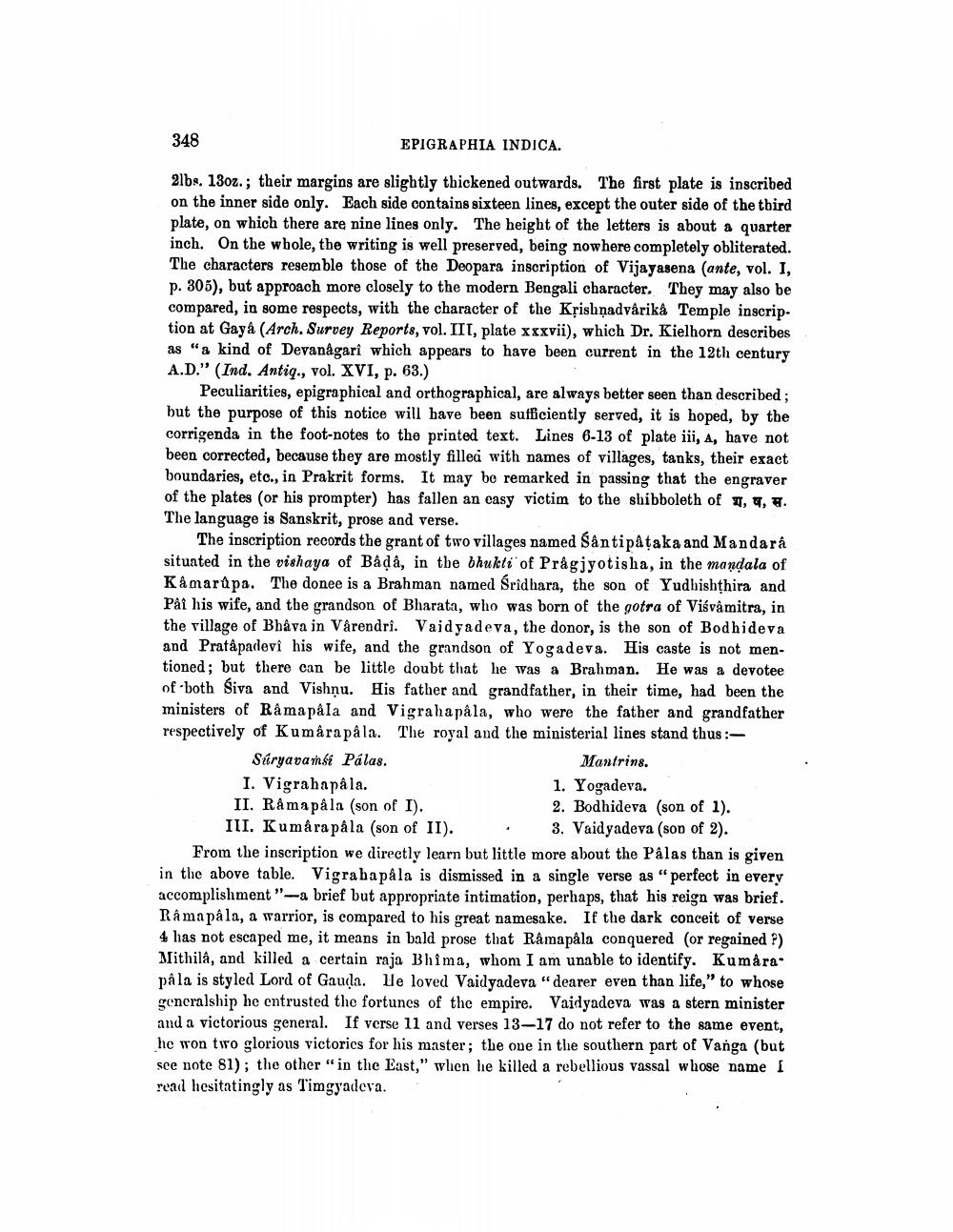________________
348
EPIGRAPHIA INDICA.
2lbs. 1307.; their margins are slightly thickened outwards. The first plate is inscribed on the inner side only. Each side contains sixteen lines, except the outer side of the third plate, on which there are nine lines only. The height of the letters is about a quarter inch. On the whole, the writing is well preserved, being nowhere completely obliterated. The characters resemble those of the Deopara inscription of Vijayasena (ante, vol. I, p. 305), but approach more closely to the modern Bengali character. They may also be compared, in some respects, with the character of the Krishnadvärika Temple inscription at Gaya (Arch. Survey Reports, vol. III, plate xxxvii), which Dr. Kielhorn describes as "a kind of Devanagari which appears to have been current in the 12th century A.D.” (Ind. Antiq., vol. XVI, p. 63.)
Peculiarities, epigraphical and orthographical, are always better seen than described; but the purpose of this notice will have been sufficiently served, it is hoped, by the corrigenda in the foot-notes to the printed text. Lines 6-13 of plate iii, A, have not been corrected, because they are mostly filled with names of villages, tanks, their exact boundaries, eto., in Prakrit forms. It may be remarked in passing that the engraver of the plates (or his prompter) has fallen an easy victim to the shibboleth of 1, 4, . The language is Sanskrit, prose and verse.
The inscription records the grant of two villages named Santipataka and Mandara situated in the vishaya of Bådå, in the bhukti of Pragjyotisha, in the mandala of Kamarupa. The donee is a Brahman named Sridhara, the son of Yudhishthira and Pâi his wife, and the grandson of Bharata, who was born of the gotra of Viśvå mitra, in the village of Bháva in Varendri. Vaidyadeva, the donor, is the son of Bodhideva and Pratápadevi his wife, and the grandson of Yogadeva. His caste is not mentioned; but there can be little doubt that he was a Brahman. He was a devotee of-both Siva and Vishnu. His father and grandfather, in their time, had been the ministers of Ramapala and Vigrahapala, who were the father and grandfather respectively of Kumâra påla. The royal and the ministerial lines stand thus :Saryavansi Pálas.
Mantrins. I. Vigrahapala.
1. Yogadeva. II. Råmapåla (son of I).
2. Bodhideva (son of 1). III. Kumarapala (son of II). . 3. Vaidyadeva (sop of 2). From the inscription we directly learn but little more about the Palas than is given in the above table. Vigraba pala is dismissed in a single verse as "perfect in every accomplishment"-a brief but appropriate intimation, perhaps, that his reign was brief. Râmapala, a warrior, is compared to his great namesake. If the dark conceit of verse 4 has not escaped me, it means in bald prose that Ramapåla conquered (or regained ?) Mithila, and killed a certain raja Bhima, whom I am unable to identify. Kumârapâla is styled Lord of Gauda. He loved Vaidyadeva "dearer even than life," to whose gencralship he entrusted the fortunes of the empire. Vaidyadeva was a stern minister and a victorious general. If verse 11 and verses 13-17 do not refer to the same event, he won two glorious victories for his master; the one in the southern part of Vanga (but sce note 81); the other " in the East," when he killed a rebellious vassal whose name I read hesitatingly as Timgyadeva.




